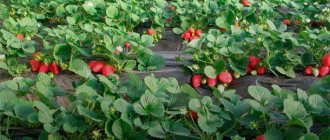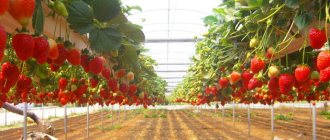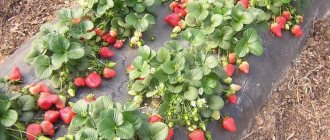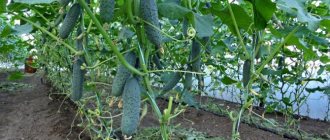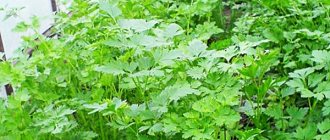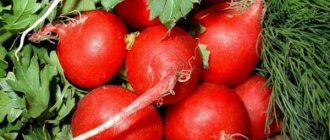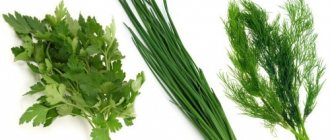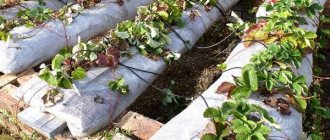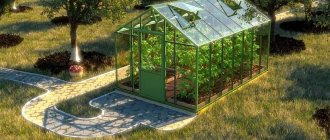The “correct” greenhouse is the key to a high yield
To grow strawberries in the cold months, you will need a permanent greenhouse. The material used as a greenhouse covering has special requirements:
- high thermal insulation;
- good light conductivity;
- strength;
- resistance to adverse climatic conditions;
- affordable price.
The most suitable materials for greenhouses are glass and polycarbonate. However, glass is not very durable. And the price for it is quite high. That is why polycarbonate greenhouses are popular among summer residents and are an ideal option for this type of work such as growing strawberries in a greenhouse in winter.
Strawberries are a light-loving plant, so the brightest and sunniest area of the dacha should be allocated for the greenhouse, without fruit trees and shrubs that can create shadow. The place must be protected from the wind.
Why cover plants for the winter?
Not all regions of our country receive sufficient snow in winter, which can serve as a natural shelter for strawberries. As a result, plants may freeze when the air temperature drops to -8° C or lower. Even if there is enough snow in winter, strong winds can sweep away this cover and the strawberries also run the risk of freezing.
In recent years, natural phenomena such as provocative thaws have become more frequent in many regions of Russia. With the onset of spring, strawberries may take the warming as a signal to awaken, but suddenly the onset of frost can destroy weakened plants. Strawberries can also freeze at the very beginning of winter, when the amount of snow that has fallen is still very small, and gusts of strong winds can destroy young leaves and even plant buds.
Many summer residents are also familiar with the concept of bulging. This occurs when recently planted plants are pushed out by frozen soil due to the lack of snow cover. Finally, strawberries that are not covered in a timely manner may lose their roots - severe frosts can completely destroy the root system.
A sufficient layer of covering material will help cope with all these problems and keep the plants alive and healthy for the next season.
Choosing a strawberry variety for growing in a greenhouse in winter
The right choice of strawberry variety is one of the components of success in growing this plant in winter. To obtain a guaranteed healthy harvest, you must adhere to the following criteria when choosing a variety:
- Regionalization of the variety. It must be acclimatized to the region in which it will grow. Even though the strawberries will be grown in a greenhouse, the variety must be zoned for the growing area.
- When choosing a strawberry variety for a greenhouse, preference should be given to remontant plants that continuously form inflorescences, form ovaries, and then berries. These varieties allow you to produce strawberries throughout the year.
- Early varieties of strawberries are distinguished by dense planting, which allows you to get a larger amount of harvest from one area.
- The development and ripening of berries grown in a greenhouse should not be affected by the length of daylight hours. Therefore, for winter cultivation, varieties of the so-called “neutral daylight hours” are used. With a fixed length of daylight hours, strawberries of these varieties will produce a stable harvest.
- Self-pollination is one of the main qualities that guarantees high strawberry yields in a greenhouse. Not every gardener will want to place evidence in the greenhouse with bees that will pollinate the plants. The manual pollination method is quite labor-intensive and time-consuming. Therefore, using self-pollinating strawberry varieties for winter cultivation is the best option.
- Variety purity is another important indicator when choosing planting material. To obtain plants of the required variety, it is better to purchase planting material from trusted nurseries, or even better, to grow strawberry seedlings yourself from seeds.
By choosing the right variety, you can be sure that your efforts will not be in vain and in winter you will be able to enjoy ripe and aromatic strawberries.
How to protect strawberries from frost for the winter
Proper covering of strawberries grown in open ground for the winter plays a key role in a successful harvest. This procedure is the final stage of preparing plants for winter.
Figure 5. Options for winter shelters
It is believed that the best and safest shelter for bushes is snow, so if your region has long and snowy winters, this will be enough to protect plants from frost. However, for regions with little snow in winters and low temperatures, artificial shelter is mandatory (Figure 5).
There are several ways to cover strawberries for the winter:
- Conifer branches: Young bushes that have recently been planted in the ground should be completely covered to protect the tender shoots from frostbite. Older plants can only be mulched around them.
- Tops, straw or leaves: These are also considered suitable and cheap cover options, however these materials have several significant disadvantages. For example, mice often live in straw, and leaves and tops become caked over several winter months and limit air circulation under the shelter. As a result, after the first thaw, strawberries may dry out. Alternatively, you can add brushwood or old raspberry stems under this mulch to improve air circulation.
- Non-woven covering material: for example, agrofibre or spandbond can be stretched over arcs and the strawberries can be left for the winter. Under such shelter, the bushes will feel absolutely comfortable, since the non-woven material allows air to pass through, but at the same time maintains the optimal temperature inside. It is impossible to cover strawberries with non-woven material without arcs, since frozen areas will form in places where it comes into contact with the soil.
Methods for growing strawberries in a greenhouse
Many summer residents ask the question: “How to grow strawberries in a greenhouse?” To answer this question, it is necessary to study various growing technologies that are highly effective.
The most popular, most expedient and cost-effective are the following methods of growing strawberries:
- in the ground;
- in small containers;
- in plastic bags.
The last two methods are united by one name - the “Dutch” method. This technology allows you to grow strawberries both horizontally and vertically, in one or several rows. This makes it easier to care for greenhouse strawberries and increase the plant’s yield per square meter. Strawberries in the greenhouse in bags and small pots are grown only through seedlings.
The entire greenhouse installation process includes several stages.
- Preparing a solid foundation. To do this you need:
- level the soil surface;
- form holes 40x40 cm every 60 cm;
- connect the holes with trenches at least 20 cm wide;
- Channels are installed in the pits and concreted;
- after the concrete solution in the pits has hardened a little, fill the trench, having previously installed the formwork.
- Installation of the frame. It can be of different shapes: rectangular, round, single or gable.
- Polycarbonate sheathing.
It’s not difficult to assemble the structure yourself, but you can also purchase a ready-made polycarbonate greenhouse, which will save time.
Soil for growing
To obtain high strawberry yields in a greenhouse, it is necessary to use highly nutritious soil. The best option is to use soil after cereal crops. You can also take turf soil, but it must be “lightened” with rotted sawdust. Agronomists do not recommend using soil for strawberries after cruciferous crops and potatoes.
To enrich the soil intended for growing strawberries in winter, it is necessary to add organic (manure, compost, peat) and mineral (superphosphate, potassium, urea) fertilizers. The technology for growing strawberries in a greenhouse involves the use of complex mineral fertilizers intended directly for strawberries and having a balanced composition of essential microelements and nutrients.
How to increase the yield?
To increase the yield of strawberries grown in greenhouses, you can use such modern technologies as the Dutch method of growing strawberries in plastic or polyethylene bags, or in special so-called “berry containers”.
Due to the fact that both bags and containers can be placed on several levels, the strawberry yield is significantly increased. In order not to waste time and money on installing shelving, you can place bags with plants vertically.
Obtaining high-quality planting material
To grow strawberries in the winter months, you need to take care of obtaining high-quality planting material for the greenhouse in mid-summer. You can obtain seedlings for planting in a greenhouse using the tendrils of mother plants growing in open ground.
Even during fruiting of the uterine bushes, it is necessary to select the best ones that produce a large number of ovaries and fruits. It is from them that you should leave mustaches with young sprouts, which will later be used in the greenhouse. No more than 4-5 rosettes can be left in one bush, so that young plants can receive adequate nutrition from the mother bush and develop actively.
In July, rooted plants are separated from the mother bushes and planted in a temporary bed. In mid-autumn (October), strawberry seedlings are transplanted into small pots and stored in a cool place (+2 - +5) until mid-November. It is at this time that the planting of young plants in a permanent place begins. Rooting and bud formation for the future harvest require short daylight hours, so no additional lighting is required for mid-January.
Growing all year round
How to grow strawberries in a greenhouse all year round? Growing strawberries in a greenhouse requires certain knowledge and adherence to technology. Then a good result will be ensured.
Choosing a greenhouse
This is an important factor, because the greenhouse must meet such requirements as good thermal insulation, light transmittance, strength and resistance to adverse weather conditions.
The most suitable options are glass and polycarbonate. How to build a greenhouse for growing strawberries with your own hands, read on our website.
You can find out more about how to build and strengthen a polycarbonate greenhouse, how to make an arched one, a lean-to (wall-mounted) one, from window frames, or choose a ready-made greenhouse, as well as how to correctly position the building on the site.
Planting material
largely depends , so it is better to purchase it from trusted nurseries. The second option, which is more reliable, is to grow it yourself from already proven varieties. It is best to select planting material from plants grown in open ground.
To do this, during the summer, select the strongest, best-bearing bushes. Mark them with a stick with an inscription. At the end of July, collect the strongest, well-rooted mustaches with a developed rosette. They can be transplanted to a separate place, so that by mid-autumn (approximately the end of October) they can be transferred to a permanent place in the greenhouse.
Soil preparation
When growing strawberries using Russian technology, the soil is prepared as follows:
- the bottom of the prepared bed is covered with expanded clay or small crushed stone to a depth of 5-7 cm;
- followed by a layer of sand from 8 to 10 cm;
- a layer of fertile soil is laid on top of the sand and fertilized with superphosphate and ammonium nitrate (10 g per 1 sq. m).
Peat can be added to the soil; it will not only give it porosity, but also provide the required level of acidity. In addition to the above fertilizers, you can also add potassium chloride (15 g per 1 sq. m). In Dutch technology, when using pots, the soil must be sterile, non-toxic and porous. You can use steamed peat with sand, coconut fiber, or perlite. The soil must be prepared long before planting strawberries.
Do not use for strawberries after potatoes or cruciferous crops (all types of cabbage, lettuce, radishes). The most suitable land is one where cereal plants were grown.
Landing
Planting takes place from late October to late November or late February - early March. To plant rosettes, 8-10 cm depressions are made in the garden bed. The distance between the bushes should be about 30 cm. To avoid long-term adaptation of the plant to a new location, it is best to transplant the planting material by transshipment, leaving more soil on the roots.
When planting, do not cover the growing point with soil . Immediately after planting, the soil is mulched with sawdust to retain moisture. You should not cover the bed with film in the greenhouse; this can lead to stagnation of moisture and rotting of the roots. The first days in the greenhouse the temperature should be maintained at least 25°; subsequently, it can be gradually lowered to 15°.
Photo of strawberries in a greenhouse:
Temperature and humidity
Strawberries in a greenhouse in winter place increased demands on the room temperature, which is why this plant is considered finicky when grown indoors. If after planting young plants the temperature should not rise more than 10, then as they grow it should be gradually increased to 18-20. As soon as the first flowers appear, in order to avoid the fall of the ovary, the temperature rises to 23-25. At very high temperatures, growth of the green mass of the plant is noted to the detriment of fruit formation.
Air humidity is also of great importance for the formation of a high yield. So, after planting seedlings, for better survival, air humidity should not drop below 85%. In the future, the humidity must be gradually reduced to 75%. During flowering and fruiting, air humidity should not exceed 70%. This is the only way to get rid of various fungal diseases.
Covering time for strawberries
In order to insulate strawberries in a timely manner, it is first important to understand the meaning of the temperature regime for them. Then the gardener will be able to draw the right conclusions about the full development of the crop, existing threats and critical temperatures.
The main feature of garden strawberries and strawberries is that their root zone is located at a depth of 6–8 cm. These soil layers freeze even with slight frost. If the above-ground part of the bush can withstand such conditions, then during a period of sharp temperature changes, the bush dies.
It is impossible to unequivocally answer the question at what temperature it is worth starting to build a shelter in a strawberry bed. After all, the winter-hardy qualities of varietal plants play a significant role. For example, for some, a temperature of -4ºС may be critical, while others will survive -8ºС. In addition, it is worth considering that strong gusts of wind reduce the temperature in the area.
Experts advise beginning gardeners to start covering their strawberry plots at the first frost. It is important to focus on the monthly forecasts of weather forecasters, since the coming warming after the temperature drops to sub-zero may destroy strawberries.
Light regime when growing strawberries in a greenhouse in winter
Without optimal lighting, you may not expect high strawberry yields in the winter season. For proper development, plants need to extend the daylight hours to 12 hours during the development of peduncles, flowering and fruiting. You can do this as follows:
- in the morning the lighting turns on at 8 a.m. and turns off at 11 a.m.;
- in the evening it starts at 17:00 and ends at 20:00.
Thus, greenhouse strawberries receive the required amount of light. For plants in “neutral daylight” this time is quite enough for quality development.
Many gardeners who grow strawberries in a greenhouse in winter use a drip system for watering. Using the same system, you can introduce the necessary liquid fertilizers. During the entire growing season, plants should be fed with a solution of superphosphate and potassium salt. This procedure must be carried out every six months.
By following these basic rules, every gardener can be sure that fresh strawberries will appear on his table on frosty winter days.
How to keep strawberries from freezing and how can you insulate them?
Many, even experienced, gardeners often wonder how to cover a strawberry front garden. After all, here it is important not only to strictly follow the shelter technology, but also to correctly select the necessary material.
Some solve the problem by purchasing specialized canvases, while others make do with improvised means. Judging by the reviews, agrofibre, various types of vegetation and sawdust have gained greater trust among consumers. Read on to learn about the advantages and disadvantages of each option.
Agrofibre
This is an advantageous alternative to polyethylene film, obtained by melting polypropylene (also called spunbond). The material is environmentally friendly, allows air to pass through well, promoting aeration of the roots, but at the same time does not block sunlight and retains heat. It can be used to protect against birds, hail, frost, and weed activity.
Under cover, the crop can develop unhindered and absorb moisture from outside.
Experts call the main advantage of this option a moderate concentration of moisture and heat , which makes it possible to bring the internal climate as close as possible to the ideal. In addition, the fiber is characterized by high wear resistance and strength.
- Among the disadvantages it is worth noting:
- high cost;
- the need to measure the beds in order to calculate the required amount of canvas;
- each bush will need to make a separate cut;
- there is a high risk of damage to the crop in the spring, when it will be necessary to remove the cover.
The assortment includes white and black agrofibre. The first option is intended for the greenhouse effect, since it allows oxygen to pass through well and allows plants to grow. The second is used exclusively for mulching. Its essence is to kill weeds and create the necessary microclimate in the inner spheres of the earth.
Vegetation
We are talking about the use of fodder hay, mown grass, fallen leaves, tops, straw, spruce branches, straw . All these materials retain heat well, but at the same time they pose a threat to strawberries, being a cozy abode for wintering pests.
Residues of grains in the straw can attract rodents to the garden bed. Wet mulch begins to rot, thereby destroying the plants underneath. With a gust of strong wind, the shelter can fly away, exposing a cold-sensitive crop.
Of all the above, the most harmless is spruce branches, the needles of which help retain snow on the rows, but do not retain heat well.
Experts advise in regions with cold winters not to resort to such experiments and to insulate the plantation using agrofibre.
Sawdust
This is an effective and affordable shelter option that allows oxygen and water to pass through well, and also retains the desired microclimate. its benefit lies in the fact that, when wet, small particles do not scatter when the wind blows.
However, for regions with unstable snow precipitation, such a shelter threatens freezing, since a wet ball on the surface of the earth acts as a conductor of cold to the root system of the bushes.
You can ensure a successful winter for the plant under such shelter by first covering the bushes with some kind of frame, for example, spruce branches or polyethylene. If frost falls on dry ground, sawdust can be poured directly onto the strawberry tops.
It is preferable to harvest sawdust from deciduous trees, since coniferous trees contribute to the formation of an acidic soil environment. No more than a bucket will be needed per square meter of plantation. The protective layer of mulch should be about 7–9 cm.
In spring, it is important to carefully remove all particles of covering material. Otherwise, it will oxidize the soil, which is contraindicated for strawberries.
Strawberry care
To produce strawberries in winter, cultivation must meet all the requirements of this crop. Plant care must be appropriate.
Temperature support
After planting the plants in the greenhouse, the temperature is gradually increased to 8°...12°C. You should not increase the temperature too sharply; plants react poorly to a temperature jump. When the number of sunny days increases, the temperature in the greenhouse can be increased to 15°...20°C. At night the temperature should remain +8°C.
At the moment of flowering, strawberries need high temperature, so at this time it should be at least 22°C. Flowering will slow down and take a long time if the temperature is low. This circumstance will also have a negative effect on the ovary of berries.
Watering and air humidity
Strawberries are moisture-loving plants. It requires regular watering. High humidity is required. It is necessary to follow the rules for maintaining the water regime:
- Do not allow the soil to dry out.
- When watering, water should not touch the stems, leaves, or peduncles.
- You need to water with warm water.
- As plants develop, it is necessary to increase the amount of watering.
Air humidity is no less important for strawberries. When planting bushes, it should be at least 80%, when it begins to bloom - at least 70%.
The drip irrigation method is used most often today because it allows you to achieve good results:
- distribute the enemy evenly between plants;
- water plants at any time without human presence;
- reduce the amount of water consumed;
- do not compact or erode the soil;
- water and fertilize plants using one system.
Light mode
In order for strawberry bushes to develop well, bloom and bear fruit, sufficient light is necessary. In winter, natural light will not be enough, so it is necessary to artificially extend daylight hours. Fluorescent lamps will help.
For normal flowering and the appearance of ovaries, an 8-hour daylight hours is sufficient. If you want to get the harvest earlier, you can increase the daylight hours to 14 hours.
Strawberry fertilizer
Once a week during the flowering period, it is necessary to feed the strawberries with liquid fertilizer. Before applying it, the soil needs to be watered. Liquid fertilizer is prepared from 10 liters of water, in which 20 g of superphosphate, 17 g of potassium salt, and 10 g of saltpeter are diluted.
You can use an aqueous solution of bird droppings (1:15) for feeding. Stop feeding if ovaries begin to form on the bushes.
When to cover strawberries
Strawberries covered early for the winter may begin to rot under a layer of covering material, and plants covered late risk freezing. The timing of the start of shelter may be different for each region of the country, however, throughout almost the entire territory of Russia, September and October are quite warm months and are not suitable for sheltering plants.
Monitor the air temperature and the first frosts - when the temperature first stays in the sub-zero zone for a week or more, you can safely go to the plot and insulate the strawberries. During this period, the soil manages to freeze by only 2-3 centimeters - this is not at all detrimental to the root system.
How to choose strawberry seedlings?
After you decide on the strawberry variety that is suitable for you, you can choose seedlings. If you are starting to grow strawberries for the first time, it is better to purchase seedlings from specialized nurseries, where they have undergone all the necessary preparation before planting.
Experienced gardeners know what to look for before buying strawberry seedlings:
- The color of the leaves should be even and rich. They should not have any defects - stains, wrinkles, etc.
- The number of leaves on each bush should be at least 3 pieces.
- The root collar must have a diameter of at least 5 mm, without spots or signs of rot.
- The roots must be no shorter than 7 cm, healthy, strong, and without damage.
Covering methods
There are a lot of ways to cover strawberries for the winter - the main thing is to choose the most preferable one, not only for yourself, but also for the plants. So, healthy, perennial, well-developed bushes should simply be covered with shelter, but young and weak bushes should be completely covered.
One common way to cover strawberry plants is mulching. Dry straw, leaves, tree bark, sawdust, hay, shavings, pine needles, humus, peat, grass and even cardboard and paper are natural materials used in soil mulching. Mulch is spread around the strawberry bushes in a layer of 10-20 cm, as well as between the rows, so that frost cannot reach the roots of the plants.
To preserve snow on the beds, it is recommended to install a low fence around the strawberry plantation (for example, made of PVC panels, boards, etc.). Garden buildings will also help protect the beds from the winds.
Shelter materials
Materials for covering strawberries can be either natural or artificial. Their main task is to keep plants alive and healthy until the onset of spring warmth.
Natural covering materials can serve as:
- spruce branches,
- dry stalks of corn or reeds,
- fallen tree leaves,
- sunflower stems,
- peat or humus,
- hay or straw
- tyrsa (shavings),
- own strawberry foliage, etc.
When covering strawberries with natural materials, give preference to those that will not only warm the plants in winter, but also saturate the soil with useful substances when the snow begins to melt (humus, peat, etc.).
Agrofibre
Modern amateur gardeners do not bother collecting dry leaves, pine needles or sawdust to cover strawberries - they replace them with agrofibre. It is an environmentally friendly, non-woven material that has undergone special anti-UV treatment. Very light, transmitting sunlight and allowing plants to breathe, this material can protect bushes from frost.
Agrofibre has many analogues:
Straw
Straw is a natural protection for plants, which not only protects from frost, but also prevents plant rotting. The fact is that straw is capable of releasing fungicides - disinfectants that fight mold and fungi. Strawberries under such protection are not only warm, but also healthy.
Foliage
The foliage of broad-leaved trees is an excellent covering material for strawberries. Summer residents give the greatest preference to oak leaves - they are less susceptible to rotting than others, and, therefore, can serve for a long time as a winter “blanket” for bushes.
Spruce and pine spruce branches
You can build excellent protection for strawberries for the winter from pine or spruce branches. Needles can not only retain heat in the garden bed, holding a thick layer of snow, but also protect strawberry bushes from unwanted attacks by rodents: voles, mice, etc. These animals do not like the smell of pine needles.
Inorganic and organic mulch
Inorganic mulch, which uses pebbles, stones, sand, gravel, black polyethylene, etc., is good because it does not attract parasites and plant pests, and also does not decompose and can serve as cover for many years. In contrast, organic mulch is subject to decomposition, attracts various insects, but perfectly saturates the soil with useful substances.
What kind of strawberry crop you will harvest in the new season depends only on you and the method of plant protection you choose. Treat this procedure with full responsibility and care, the result will not disappoint you!
